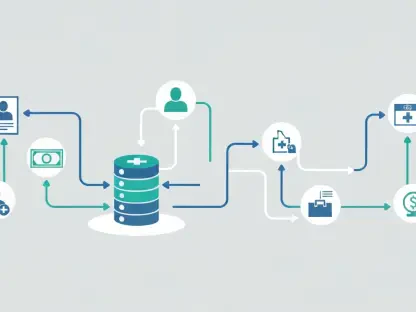As the digital world grows more complex, the role of data modeling software becomes crucial for businesses seeking to navigate massive data volumes. This technology plays a key part in organizing and making sense of data, and its market is expanding as organizations pursue digital advancement. With an eye toward the year 2030, it’s clear that this market is on an upward trend. Various drivers are propelling its growth, and the commercial impact is significant. Data modeling software is not just an enabler for managing information but a necessary tool that companies across industries are increasingly relying on to remain competitive and agile in the data-driven era. This exploration tracks the rise of data modeling software and its market, acknowledging the technological leaps that contribute to its importance in our digital future.
The Rising Demand for Data Modeling Software
The digital transformation crusade is intensifying, fueling the demand for solutions that bring clarity and agility to data management. Advanced data modeling software is at the forefront of this transformation, acting as a linchpin in organizing complex data sets for enterprises to harness. The current market trend underscores an escalating requirement for these tools in an array of industries, further accentuated by the rapid digitization of businesses. The imperative of data modeling software is its capacity to distill and elucidate data architectures, thereby rendering intricate data structures into actionable insights. In this dynamic digital milieu, data modeling tools not only streamline data comprehension but also empower data-driven decision-making, thereby serving as indispensable enablers for business intelligence.
Key Trends and Drivers of Market Growth
The Data Modeling Software Market is thriving, propelled by advancements in cloud computing, big data, AI, and machine learning. These technologies depend on turning massive data into actionable insights, making data modeling tools essential. Quality, precision, and timeliness in data handling are crucial, and such software is at the heart of making these technologies more effective. As industries increasingly rely on data, data modeling software’s ability to organize and make sense of this data is becoming indispensable for innovation and improved efficiency. The demand for data modeling reflects the growing need for tools that can handle the complexity and scale of data processed today. These tools not only support current tech developments but also enable businesses to harness their full potential by providing a structured framework for data analysis and decision-making.
Market Segmentation and Industry Adoption
Data modeling software has found resonance across varied sectors, demonstrating its versatility and adaptability to diverse industrial requirements. From governance and public administration to the intricate realms of aerospace and defense, the imprint of data modeling tools is evident. This software market is dissected by numerous aspects such as the array of applications it serves, the deployment models (cloud-based or on-premises), the variety of package offerings, the end-user demographic, and the compatibility with different operating systems. This segmentation is indicative of the multifarious ways in which data modeling software can be tailored to meet the demands of individual industries and users, paving the way for vast adoption and integration into business operations.
The Impact of Cloud-Based Solutions
The Data Modeling Software Market is experiencing a significant shift as businesses gravitate towards cloud-based solutions, recognizing their critical role in digital transformation. Cloud compatibility has now become a defining feature of modern data management tools, offering enhanced flexibility and scalability key to succeeding in today’s digital economy. The move to the cloud is driven by the need for agile and accessible data handling capabilities that support business growth and innovation.This trend underscores the increasing reliance of companies on state-of-the-art data modeling platforms that are easily integrable with the cloud. As organizations pivot their operations to the digital sphere, they are steadily increasing their investment in advanced data modeling technologies. This not only represents a paradigm shift in how enterprises approach data management but also points to their eagerness to leverage cutting-edge tools that can provide a competitive advantage in a rapidly evolving digital marketplace.Consequently, the demand for cloud-compatible data modeling solutions is surging. Companies are actively seeking out software that can streamline their data processes, improve operational efficiency, and facilitate better decision-making. The data modeling software market is therefore expanding, fueled by the need for systems capable of adapting to complex data environments, ensuring that businesses stay ahead in the race toward digital proficiency and market leadership.
Competitive Landscape and Key Players
A constellation of innovative players propels the Data Modeling Software Market, each contributing their unique technological sensibilities to the field. Leading entities such as SAS Institute Inc., IBM, Erwin, Inc., and others are at the helm, steering the market through strategic maneuvers and product enhancements. The dissection of their market presence, the strategies they deploy, their geographical stronghold, and sales performance depicts a competitive terrain ripe with innovation and collaboration. This dynamic interplay not only shapes the market’s current echelons but also holds implications for future industry propositions, as these key actors continue to drive the data modeling software narrative forward.
Future Projections and Market Potential
Market experts predict a significant upswing in the Data Modeling Software Market’s growth continuing through to 2030. Driven by advancements in technology and an ever-growing demand for digital modernization, this market is on a path to noteworthy expansion. Data modeling software is increasingly becoming a key tool in organizations’ quests to harness data for strategic insights, evident in its burgeoning potential and the marketplace’s resulting opportunities.As businesses globally steer towards more data-centric decision-making processes, the utility of data modeling software is magnified. With the advent of predictive analytics, companies are better equipped to forecast trends, optimize operations, and innovate products, underlining the market’s potential. Investments in this sector are becoming progressively attractive as stakeholders recognize the critical intersection of technological innovation and market needs, which is fertile ground for future growth.The Data Modeling Software Market stands to benefit not just from a breadth of industries seeking to transform digitally but also from continuous technological enhancements that amplify its effectiveness and efficiency. As we advance, the convergence of these elements provides a strong case for the market’s expansion and a compelling opportunity for investors and businesses alike to position themselves advantageously within this dynamic domain.
Technological Advancements Fueling Market Expansion
The path ahead for the Data Modeling Software Market is paved with continuous technological advancements, ensuring its relevance and vitality for years to come. Key to this progression is the unceasing evolution of data manipulation tools that cater to the ever-emerging complexities of digital environments. Innovation remains the cornerstone of market progression, as data modeling solutions must dovetail with the brisk pace of digital transformation, providing seamless, agile, and intelligent interventions for the future of data-driven decision-making.In sum, the Data Modeling Software Market stands at the threshold of an exciting future, underpinned by the relentless march of technology and the indomitable spirit of digital renovation. Its anticipated surge by 2030 is a testament to its enduring relevance and the central role it plays in deciphering the data deluge of the digital era.









